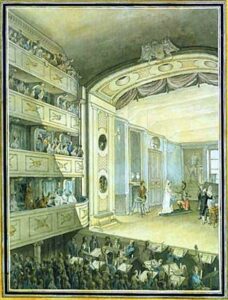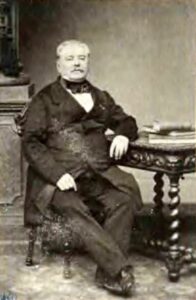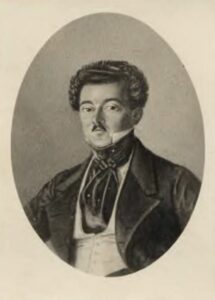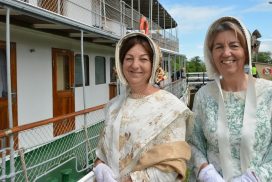4. Laetitia (Letty) Backman (Norman) and the Royal Theatre
The theatre was a magical place. It was a world like no other. Letty loved the times she was allowed to come with her father to the theatre. Later in life, when she reflected on her happy childhood, there was one memory that stood out. It would have been in 1839 because she remembered that she was almost 12 years old.
Her father, the director of the Royal Theatre, had just returned home from a visit to the Royal Palace. He was in a great mood and had asked if she wanted to see a final rehearsal at the theatre the following day. The opera, Robert of Normandy, was to open in two days.
The next day, she and her father arrived at the Royal Theatre and her father introduced her to the women performers. She remembered the opera singers, Mathilda Gelhaar, Jenny Lind, and Mina Fundin, the actress Charlotta Almlöf, and the ballerinas, Sophie Daguin and Adolfina Fägerstedt. They were so friendly and lively. They were not stodgy like the women who would come to visit her mother. And oh, were they beautiful! The only disappointment, and surprise, was that they did not wear their costumes at the dress rehearsal. She had so much looked forward to seeing the women’s dresses.
Letty got to choose where to sit, and she picked the first row on one of the balconies. She could see her father walk around on stage in his slippers, talking to the actors. Then the curtains closed and in the dim light from the oil lamps in the large chandelier, she waited. She could see the orchestra getting ready and the conductor looking out over the musicians and their shiny instruments. Robert of Normandy was an opera in five acts by composer Giacomo Meyerbeer. He had named the opera, Robert le Diable, but in Stockholm, they had given it a different name.
As the conductor raised his baton, the music started and the main curtain was raised. The illuminated stage revealed a beautifully painted backdrop. And on stage was a group of men. One of them was supposed to be Robert, but it wasn’t obvious who it was as they were still in their regular clothes. She remembered the chills when they started singing. Oh, could they sing! Letty forgot her disappointment that they were not in costume because it didn’t matter. She was mesmerized. If she only had the talent, she would love to work at the theatre when she grew up.
Watching Robert of Normandy became one of her most cherished childhood memories. Maybe because it was the first opera she saw at the theatre, and maybe it was because she felt like she had been part of the theatre family.
Many years later, when she saw Jenny Lind, who had become an international sensation, she remembered Lind’s performance as Alice in Robert of Normandy. It had been one of Jenny Lind’s first major performances.
Laetitia (Letty) Charlotta Juliania Backman
Letty Backman was listed as number 4 of the girls who got confirmed in St Jacob’s church. That should have been no surprise as her father was a colonel, an adjutant to King Carl XIV Johan, and the Director of the Royal Theatre (the opera house in Stockholm).
Letty was born on 11 July 1827 to Alexis Backman (1794-1871) and Lovisa Christina Strömbäck (1797-1873). She had a 2-year younger brother, named Alexis after his father. In 1844, when Letty was attending confirmation classes, the family lived at Mäster Samuels Gränd No. 48. That was two houses away from where Augusta’s friend Lotten lived. Letty’s father’s last year as director of the theatre was in 1844. The same year, Alexis Backman became the Postal Inspector in the town of Gävle, and the family left Stockholm.
Two years later, on October 12, 1846, Letty married Carl Magnus Norman in Gävle. Carl Magnus was born in Falun but was a wholesale merchant in Gävle. Carl Magnus and his older brother August were both in the business of trade, but Carl Magnus seemed to have embraced more risky businesses. He was even described as a swindler. In 1849, he was forced to declare bankruptcy and many, included his brother who had lent him large amounts for his lofty businesses, were affected by the bankruptcy.
In 1857, Letty, Carl Magnus, and their one-year-old daughter Lilia (Lilli) moved to Stockholm. They were doing well and got an apartment at a prestigious address – the corner of Drottninggatan and Karduansmakaregränd, just a few blocks from the Royal Theatre. I can imagine Letty’s excitement about that move! She was back home, and she was still young, only 30 years old.
She would raise her children here, and someday, when they were old enough, she could take them to the theatre.
Little Lilia Blenda was born in 1856. Then came Carl Justus, born in 1859, followed by Alexis in 1867, and Anna Laeticia in 1869. By that time, they had moved to Nya Kungsholmsbrogatan 23, which was just kitty-corner to their old home.
In 1884, Carl Magnus died at the age of 68. He had been ill for some time and the cause of death was recorded as an organic heart defect. Letty died 9 years later, in 1893, and at the age of 65.
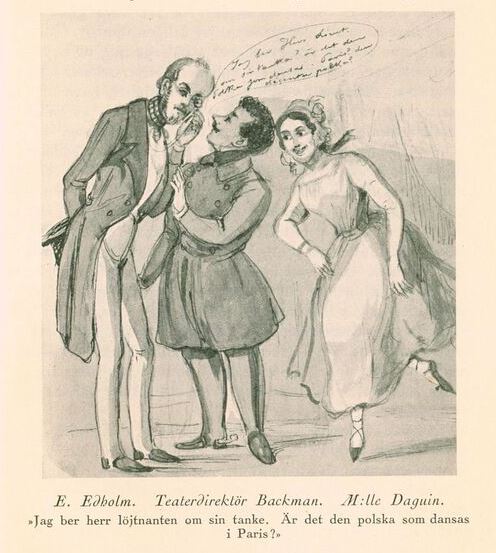
Augusta’s acquaintance, Erik Edholm, Theatre Director Alexis Backman, and Sophie Daguin. Drawing by Fritz von Dardel
_______
Sources:
Plays performed at the Royal Theatre during 1839-1840:
https://sv.wikisource.org/wiki/Svenska_teatern/Spel%C3%A5ret_1839-1840
About the actresses at the Royal Theatre:
https://en.wikipedia.org/wiki/Mathilda_Gelhaar
https://en.wikipedia.org/wiki/Wilhelmina_Fundin
https://en.wikipedia.org/wiki/Adolfina_F%C3%A4gerstedt
https://en.wikipedia.org/wiki/Charlotta_Alml%C3%B6f
About Robert le Diable:
https://en.wikipedia.org/wiki/Robert_le_diable
https://www.youtube.com/watch?v=VGOJ7QexcOA
An interesting and entertaining piece about the Royal Theatre (in Swedish):
About theatre contracts and women’s theatrical costumes (in Swedish):
In the 1830s, women actresses were supposed to provide their own costumes for contemporary plays. Wearing the latest fashion was therefore important but costly for the underpaid actresses. Some actresses, like Sophie Daguin and Emilie Högqvist, became mistress to wealthy men, which helped with their expenses. The following thesis (in Swedish) deals with the topics of theatre contracts and the history of theatrical costume in Sweden:
https://su.diva-portal.org/smash/get/diva2:1056001/FULLTEXT01.pdf
A memoir by a Swedish actress (in Swedish):
Henriette Wideberg: En skådespelerskas minnen.
About Carl Magnus Norman and his businesses (in Swedish):
Additional Sources (contemporary diaries):
Letty was a good friend of Marie-Louise Forsell, who kept a detailed diary which was published posthumously. Letty is often at Marie-Louise’s house and in the company of some of the other girls in the confirmation class.
Heijkenskjöld, Syster, ed. 1915. Sällskapslif och hemlif i Stockholm på 1840-talet: ur Marie-Louise Forsells dagboksanteckningar. Stockholm: Bonnier. (Translation of title: Social Life and Home Life in Stockholm in the 1840s: From Marie-Louise Forsell’s Diary Notes).
______
Lotten Ulrich, who lived at the Royal Palace, describes in her diary how Alexis Backman invited her and her family to attend the rehearsal of Robert of Normandy. Much of what I imagine Letty would have experienced, if she indeed had been invited, is from Lotten Ulrich’s diary. Lotten and her family were also invited to see the premiere of the opera two days later.
In addition, Lotten describes how Alexis Backman lent them props for their own theatre productions at the palace. He seems to have been a very jovial person.
Östman, Margareta. 2015. Systrarna Ulrichs dagböcker – från Stockholms slott, Djurgården och landsorten 1830-1855. Stockholm: Carlssons. (Translation of title: The Ulrich Sisters’ Diaries – from Stockholm’s Palace, Djurgården, and the Countryside 1830-1855).
